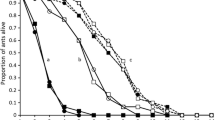Abstract
This paper reports the first discovery of “propaganda substances” in a workerless inquiline ant, the European myrmicineLeptothorax kutteri Buschinger. These substances are used by the parasite queen as a chemical weapon for defense against hostile workers of the host speciesL. acervorum. The substances also have an unusual behavioral effect: they cause host workers to attack each other, and they therefore appear to override nestmate recognition in host colonies. Laboratory experiments show that the source of these substances is the Dufour's gland of theL. kutteri queen. Our experiments also confirm the hypothesis that the closely related slave-making antHarpagoxenus sublaevis uses its Dufour's gland secretions as a chemical weapon during slave raids and colony foundation. The behavioral effect of these slave-maker secretions is identical to that ofL. kutteri queens.
Similar content being viewed by others
References
Alloway, T. 1979. Raiding behavior of two species of slave-making ants,Harpagoxenus americanus (Emery) andLeptothorax duloticus (Wesson) (Hymenoptera: Formicidae).Anim. Behav. 27:202–210.
Brown, W.L. 1955. The first social parasite in the ant tribe Dacetini.Insectes Soc. 2:181–186.
Buschinger, A. 1965.Leptothorax (Mychothorax) kutteri n.sp., eine sozial-parasitische Ameise (Hymenoptera, Formicidae).Insectes Soc. 12:327–334.
Buschinger, A. 1974a. Experimente und Beobachtung zur Gründung und Entwicklung neuer Societäten der sklavenhaltenden AmeiseHarpagoxenus sublaevis (Nyl).Insectes Soc. 21:381–406.
Buschinger, A. 1974b. Zur Biologie der sozialparasitischen AmeiseLeptothorax goesswaldi Kutter (Hym., Formicidae).Insectes Soc. 21:133–144.
Buschinger, A. 1981. Biological and systematic relationships of social parasitic Leptothoracini from Europe and North America, pp. 211–222,in P.E. Howse, J.L, Clément (eds.). Bio-systematics of Social Insects. Academic Press, New York.
Buschinger, A., Ehrhardt, W., andWinter, U. 1980. The organization of slave raids in dulotic ants—a comparative study (Hymenoptera; Formicidae).Z. Tierpsychol. 53:245–264.
Douwes, P., andBuschinger, A. 1983. Två för Nordeuropa nya myror.Entomol. Tidskr. 104:1–4.
Dumpert, K. 1981. The Social Biology of Ants. Translated by C. Johnson. Pitman, London.
Gösswald, K. 1953. Histologische Untersuchungen an der arbeiterlosen AmeiseTeleutomyrmex schneideri Kutter (Hym. Formicidae).Mitt. Schweiz. Entomol. Ges. 26:81–128.
Gösswald, K. 1954. Unsere Ameisen. Kosmos, Stuttgart.
Hölldobler, B. 1970. Zur Physiologie der Gast-Wirt-Beziehungen (Myrmecophilie) bei Ameisen. II. Das Gastverhältnis des imaginalenAtemeles pubicollis Bris. (Col, Staphylinidae) zuMyrmica undFormica (Hym. Formicidae). Z.Vergl. Physiol. 66:176–189.
Hölldobler, B. 1971. Communication between ants and their guests.Sci. Am. 224(3):86–93.
Kistner, D.H. 1979. Social and evolutionary significance of social insect symbionts, pp. 339–413,in H.R. Hermann (ed.). Social Insects, Vol. I. Academic Press, New York.
Kutter, H. 1969. Die sozialparasitischen Ameisen der Schweiz.Neujahrsblatt hrsg. von der Naturf. Ges. Zurich 171:1–62.
Passera, L. 1964. Données biologiques sur la fourmi parasitePlagiolepis xene Starcke.Insectes Soc. 11:59–70.
Regnier, F.E., andWilson, E.O. 1971. Chemical communication and “propaganda” in slave-maker ants.Science 172:267–269.
Rissing, S.W. 1983. Natural history of the workerless inquiline antPogonomyrmex colei (Hymenoptera: Formicidae).Psyche 90:321–332.
Stumper, R. 1950. Les associations complexes des fourmis. Commensalisme, symbiose et parasitisme.Bull. Biol. Fr. Belg. 84:376–399.
Vander Meer, R., Wojcik, D. 1982. Chemical mimicry in the myrmecophilous beetleMyrmecaphodius excavaticollis.Science 218:806–808.
Wheeler, W.M. 1910. Ants: Their Structure, Development and Behavior. Columbia University Press, New York.
Wilson, E.O. 1971. The Insect Societies. Belknap Press of Harvard University Press, Cambridge, Massachusetts.
Winter, U. 1979. Untersuchungen zum Raubzugverhalten der dulotischen AmeiseHarpagoxenus sublaevis (Nyl).Insectes Soc. 26:123–135.
Author information
Authors and Affiliations
Rights and permissions
About this article
Cite this article
Allies, A.B., Bourke, A.F.G. & Franks, N.R. Propaganda substances in the cuckoo antLeptothorax kutteri and the slave-makerHarpagoxenus sublaevis . J Chem Ecol 12, 1285–1293 (1986). https://doi.org/10.1007/BF01012348
Received:
Accepted:
Issue Date:
DOI: https://doi.org/10.1007/BF01012348




